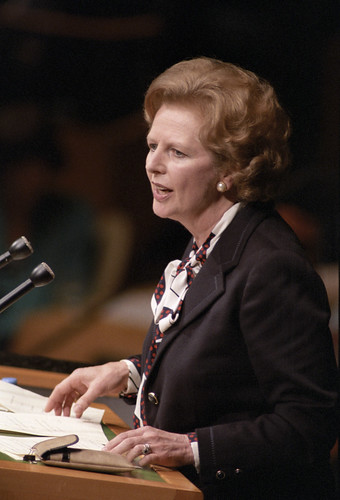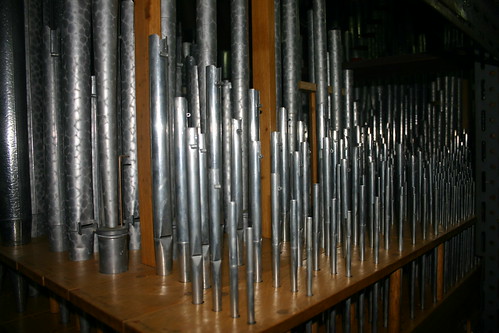
La Victoire de Samothrace by caribb on flickr
One year before the workshop one of the organisers, Miriam Yagud, booked the twelve available rooms at Woodbrooke with some trepidation; she was not sure that her proposal would attract twelve attendees. In the event around eighty people applied to come and (using overflow accommodation) roughly forty were able to attend, including my Mum and me.
We started on the Friday evening with a ‘get to know yourself’ session. Miriam used a game to get us thinking about ourselves and our Quakerism. We broke into groups of six and each group member delved into a bag to retrieve two objects, without peeking, the first would represent you and the second your Quaker faith. I was left pondering how a battery might represent me and an old hiking sock my Quakerism! We used a mixture of silent reflection and discussion that served well to start the weekend getting to know ourselves and our fellow attendees better.
The first evening ended with an epilogue, a Woodbrooke tradition consisting of a short meeting for worship including a longer piece of prepared ministry from one of the groups studying there that weekend. The Churches Together group lead the session and read the Britain Yearly Meeting epistle on same sex marriage from 2009. Looking back I can see how important this was for my understanding of the weekend. The reference to George Fox’s words “Marriage is God’s work and we are but witnesses” got me thinking about how nontheists understand the role of God and of God-language within Quakerism. The epistle also underlined the importance of diversity to modern Quakerism.
Day Two started with a talk by Miriam’s fellow organiser, David Boulton, covering various definitions. David is known to many Quakers as the author of Who on Earth was Jesus?, the editor of Godless for God’s Sake, and a member of the Quaker Universalist Group, the British Humanist Association, and was editor of the Sea of Faith Network’s magazine. He talked about the various words used to describe nontheism: atheism, agnosticism, heresy, humanism, etc. and looked both at their etymology and at what they might mean for us now. Nontheism, though clumsy, appears to have become the preferred term lacking as it does some of the more aggressive critical connotations of the word atheism.
Breaking again into groups we next explored how the diversity of Quaker faith is supported in our local meeting. I was amazed at the diversity of experiences. There were nontheists present who felt isolated and silenced by their local meeting and others who felt core to their local meeting’s faith. Practises like discussion groups and ‘after words’ were reported as valuable ways to explore and nurture the diversity of beliefs among existing Quakers.
This was followed with a look at Quaker history, highlighting the role of dissenting voices. Starting with early Quakers and Ranters we heard quotes like this from Gerrard Winstanley (1609-c.1660):
“He that looks for God outside himself, and worships God at a distance, worships he knows not what, but is … deceived by the imagination of his own heart.”
Many of the nontheists on the workshop had been asked the question asked of Susan B Anthony (1820-1906): do you pray? Her answer was inspiring:
“I pray every single hour of my life; not on my knees but with my works.”
Though this historic journey was inspiring, and did show that Quaker notions of faith and of God have been diverse from our inception, I did wonder, especially reading back through my notes, just how realistic it is to claim some of these historic Friends as relevant for nontheism.
On the Saturday afternoon each of the groups at Woodbrooke had free time and so we decided to get together for silence and discussion. It wasn’t easy. Several of the Churches Together attendees felt that the conceptions of God put forward by the nontheists were too constraining of their own ideas and that our approach was too evangelical. The last point made was that we should listen to each other’s beliefs and experiences, not with the intention of changing minds but purely to understand the personal meaning of what was said and felt.
The last formal session on Saturday looked at meeting for worship and explored what we, as nontheists, do in meeting. For me this was the most troubling and the most confusing session. I had hoped to find other nontheists sharing common experiences of meeting for worship but the six people in my group all approached what happens in meeting very differently, and in ways that sometimes felt foreign to me.
After dinner we relaxed with an evening of music and poetry sharing. Most of this was uplifting but the gems turned out to be the jokes and shared humour, like this limerick recited by one of the women attending the workshop:
There was a young lady called Alice
Who peed in the Vatican Palace.
It wasn’t her need
That prompted the deed
But pure Presbyterian malice.
Saturday closed with another Woodbrooke epilogue, this time lead by David Boulton from our group. He chose to weave readings and analysis of Blake’s poem The Divine Image through the ministry:
To Mercy, Pity, Peace, and Love
All pray in their distress;
And to these virtues of delight
Return their thankfulness.
For Mercy, Pity, Peace, and Love
Is God, our father dear,
And Mercy, Pity, Peace, and Love
Is Man, his child and care.
For Mercy has a human heart,
Pity a human face,
And Love, the human form divine,
And Peace, the human dress.
Then every man, of every clime,
That prays in his distress,
Prays to the human form divine,
Love, Mercy, Pity, Peace.
And all must love the human form,
In heathen, turk, or jew;
Where Mercy, Love, & Pity dwell
There God is dwelling too.
On Sunday we shared meeting for worship with the other groups after a closing session looking forward to our next steps as a group. We worked on a minute summarizing the weekend which I’ll include at the end of this report. I came to the workshop hoping to deepen my understanding of my own beliefs, and my understanding of my Quakerism. But I feared that less subtle, more aggressive atheist arguments might dominate. In fact neither proved true. What I found instead was a fascinating community of committed nontheist Friends, many of home needed this workshop to convince them that Quakerism could still provide their home. The minute we worded reads as follows:
“There are nontheist Friends… Friends who might be called agnostics, atheists, sceptics, but would nevertheless describe themselves as reverent seekers.” So began the report of the first formal workshop for nontheist Friends, held in New York State in 1976. A generation later, nontheist Friends are a widely accepted strand in the multi-coloured fabric of theologically diverse liberal Quakerism in both the United States and Britain.
Forty Friends from all over Britain, identifying as nontheists or wishing to explore nontheist perspectives with an open mind, met in Woodbrooke this weekend. Some for whom Woodbrooke rooms were not available were accommodated in the adjacent Fircroft College but another forty would-be participants were unable to attend because of lack of available beds.
In plenary sessions and small groups, through discussion, worship and creative listening, we explored varieties of Quaker nontheism – atheist, humanist, agnostic, non-supernaturalist. We listened to the words of Friends through the ages, from the 17th to the 21st century, who declared for free thought and free expression within the Society of Friends, thereby laying the foundations on which an authentic nontheist understanding could be built within our beloved Quaker community.
In an informal session with Friends on other Woodbrooke conferences (“Becoming Friends” and “Churches Together”) many of us were able to share our different experiences of what it means to be Quakers today. We shared epilogues and joined together in meeting for worship.
In our business session we addressed the question in the title of our gathering: “What next for Quaker nontheism?” Acknowledging that the burden of organising and financing our work has tended to fall on isolated individuals, we explored ways in which we might share responsibilities in a more formally organised way. Recognising the concern among some Friends that open differences can lead to division, we looked to find a way forward that would celebrate and enhance the Society’s diversity of religious opinion. After careful thought and collective discernment we resolved to form a steering group to prepare proposals for a Nontheist Friends Group within Britain Yearly Meeting. Six names were brought forward and accepted. The steering group was asked to liaise with Woodbrooke on possible dates for a further gathering next year to continue our work and explorations.
Finally, we noted the recent statement on the Britain Yearly Meeting website, as follows:
“There is a great diversity within the Quakers on conceptions of God, and we use different kinds of language to describe religious experience. Some Quakers have a conception of God which is similar to that of orthodox Christians, and would use similar language. Others are happy to use God-centred language, but would conceive of God in very different terms to the traditional Christian trinity. Some describe themselves as agnostics or humanists or non-theists, and describe their experience in ways that avoid the use of the word God entirely.”
We expressed our appreciation of this public recognition of our diversity. We are all in the Quaker mainstream now.
(Minute and Epistle of the gathering of nontheist Friends at Woodbrooke Quaker Study Centre, Britain, Feb 18-20 2011, taken from the Nontheist Friends website)
 (Commemoration of the Fortieth Anniversary of the United Nations by United Nations Photo on flickr)
(Commemoration of the Fortieth Anniversary of the United Nations by United Nations Photo on flickr)














